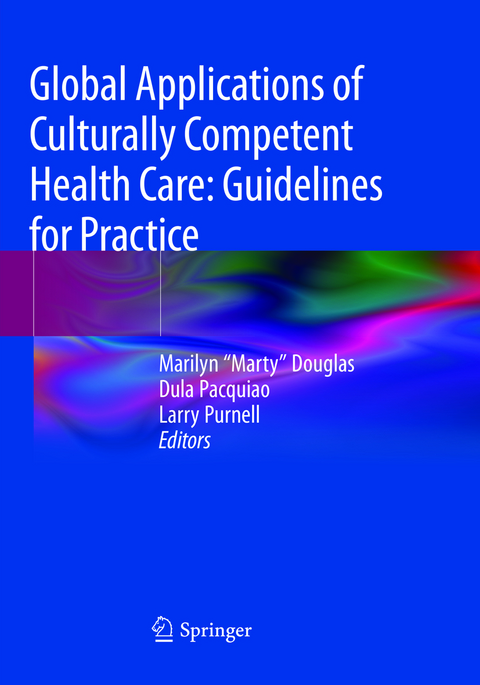
Global Applications of Culturally Competent Health Care: Guidelines for Practice
Springer International Publishing (Verlag)
978-3-030-09883-4 (ISBN)
This book is unique in its global approach to applying the Guidelines for Culturally Competent Nursing Practice that were recently endorsed by the International Council of Nurses (ICN) and distributed to all of its 130 national nursing associations. The purpose of this book is to illustrate how these guidelines can be put into clinical practice and to show how practitioners from different countries with diverse populations can implement them.
The first chapter provides the conceptual basis for Culturally Competent Health Care and describes how the guidelines were developed. Each of the next 10 sections presents a chapter describing a specific guideline followed by three or four chapters with detailed case studies to illustrate how the guideline was implemented in a particular cultural setting. All case studies follow a similar format and are written by international authors with clinical expertise and work experience in the culture being presented.
This book will be useful for advanced practice nurses, healthcare students, clinicians, administrators, educators, researchers, and those who provide community health or population-based care.
Dr. Marilyn "Marty" K. Douglas, PhD, RN, FAAN earned her PhD (International and Cross Cultural Nursing) from the University of California, San Francisco, where she is currently Clinical Professor. Dr. Douglas served as Editor-in-Chief of the Journal of Transcultural Nursing for 15 years and co-edited the Core Curriculum for Transcultural Nursing and Health Care. She chaired the American Academy of Nurses (AAN) Task Force that developed the Guidelines for Culturally Competent Nursing Practice, which ultimately were endorsed by the International Council of Nurses. She also worked with the American Nurses Association to develop a new standard of practice, "Cultural Congruent Practice". Dr. Dula F. Pacquiao, EdD, RN, CTN-A, TNS obtained her EdD (Anthropology) from Rutgers University. She served as a Senior Editor of the Journal of Transcultural Nursing, the co-editor of the Core Curriculum for Transcultural Nursing and Health Care, co-author of the TCN certification exam, and member of the AAN Task Force on Guidelines for Culturally Competent Nursing Practice. She established two academic training centres for multidisciplinary students and healthcare professionals, which focus on culturally competent care and social determinants of health in vulnerable populations. She assisted in the development of the U.S. Office of Minority Health's Culturally Competent Curriculum for Nurses and the National Quality Forum's Framework for Culturally Competent Practice. Dr. Larry D. Purnell, PhD, RN, FAAN obtained a PhD (Health Service Administration) from Columbia Pacific University. He served as Associate Editor of the Journal of Transcultural Nursing and a member of the AAN Task Force on Standards of Culturally Competent Nursing Practice. He developed one of the most popular models for cultural competence, the Purnell Model for Cultural Competence, which has been translated into 10 languages. He has been a prolific author on the topic of culture.
Chapter 1. Conceptual Framework for Culturally Competent Care.- PART I - Guideline: Knowledge of Cultures .- Chapter 2. Knowledge of Cultures: A Requisite for Culturally Competent Care.- Chapter 3. Case Study: Building Trust among American Indian/Alaska Native Communities: Patience and Focus on Strengths.- Chapter 4. Case Study: An 85-Year-Old Immigrant from the Former Soviet Union.- Chapter 5. Case Study: Caring for Urban American Indian Gay or Lesbian Youth at Risk for Suicide.- PART II - Guideline: Education and Training.- Chapter 6. Education and Training in Culturally Competent Care.- Chapter 7. Case Study: Traditional Health Beliefs of Arabic Culture during Pregnancy.- Chapter 8. Case Study: Perceived Cultural Discord and Possible Discrimination involving a Moroccan Truck Driver in Italy.- Chapter 9. Case Study: A Multiracial Man Seeks Care in the Emergency Department.- PART III - Guideline: Critical Reflection.- Chapter 10. Critical Reflection: Critiquing Self-Awareness of Personal Values and Beliefs.- Chapter 11. Case Study: Human Trafficking in Guatemala.- Chapter 12. Case Study: A Young African American Woman with Lupus.- Chapter 13. Case Study: Intimate Partner Violence in Peru.- PART IV - Guideline: Cross Cultural Communication.- Chapter 14. Cross Cultural Communication: Verbal and Nonverbal Communication, Interpretation and Translation.- Chapter 15. Case Study: Korean Woman with Mastectomy Pain.- Chapter 16. Case Study: Cross Cultural Communication: Arab Muslim Patients.- Chapter 17. Case Study: Communication, Language, and Care with a Person of Mexican Heritage with Type 2 Diabetes.- Chapter 18. Case Study: Stigmatization of an HIV+ Haitian Male.- PART V.- Guideline: Culturally Congruent Practice.- Chapter 19. Integrating Culturally Congruent Strategies into Health Care Practice.- Chapter 20. Case Study: Perinatal Care for a Filipina Immigrant.- Chapter 21. Case Study: Maternity Care for a Liberian Woman widowed by Ebola.- Chapter22. Case Study: Care of a Malay Muslim Woman in a Singaporean Hospital .- PART VI. - Guideline: Cultural Competence in Health Care Systems & Organizations.- Chapter 23. Building an Organizational Environment of Cultural Competence.- Chapter 24. Case Study: Culturally Competent Strategies Towards Living Well with Dementia on the Mediterranean Coast.- Chapter 25. Case Study: Culturally Competent Healthcare Organizations for Arab Muslims.- Chapter 26. Case Study: A Lebanese Immigrant Family Copes with a Terminal Diagnosis.- PART VII. - Guideline: Patient Advocacy and Empowerment.- Chapter 27. Advocacy and Empowerment of Individuals, Families and Communities.- Chapter 28. Case Study: Zapotec Woman with HIV in Oaxaca, Mexico.- Chapter 29. Case Study: Maternal and Child Health Promotion Issues for a Poor, Migrant Haitian Mother.- Chapter 30. Case Study: Caring for a Pakistani Male who has Sex with Other Men.- PART VIII. - Guideline: Multicultural Workforce.- Chapter 31. CulturallyCompetent Multicultural Workforce.- Chapter 32. Case Study: Internationally-educated Nurses Working in a Canadian Healthcare Setting.- Chapter 33. Case Study: Recruitment of Philippine-educated Nurses to the US.- Chapter 34. Case Study: Health Care for the Poor and Underserved Populations in India.- PART IX. - Guideline: Cross Cultural Leadership.- Chapter 35. Attributes of Cross Cultural Leadership Strategies.- Chapter 36. Case Study: Integrating Cultural Competence and Health Equity in Nursing Education.- Chapter 37. Case Study: Cross-cultural Leadership for Maternal and Child Health Promotion in Sierra Leone.- Chapter 38. Case Study: Nursing Organizational Approaches to Population and Workforce Diversity.- PART X. -- Guideline: Evidence Based Practice and Research.- Chapter 39. Designing Culturally Competent Interventions Based on Evidence and Research.- Chapter 40. Case Study: Domestic Violence of an Elderly Migrant Woman in Turkey.- Chapter 41. Case Study: Sources of Psychological Stress for a Japanese Immigrant Wife.- Chapter 42. Case Study: Early Childbearing and Contraceptive Use among Rural Egyptian Teens.- Chapter 43. Case Study: A Chinese Immigrant Seeks Health Care in Australia.
"This is valuable resource for addressing social determinants of health through advancing globally informed, culturally competent care. The authors have taken an expansive and contextual view in preparing a book that most assuredly advances the art and science of culturally competent care. ... This book is a vital resource for those working to enhance culturally competent care through implementation of the guidelines." (Sonja J. Meiers, Doody's Book Reviews, October, 2018)
“This is valuable resource for addressing social determinants of health through advancing globally informed, culturally competent care. The authors have taken an expansive and contextual view in preparing a book that most assuredly advances the art and science of culturally competent care. … This book is a vital resource for those working to enhance culturally competent care through implementation of the guidelines.” (Sonja J. Meiers, Doody's Book Reviews, October, 2018)
| Erscheint lt. Verlag | 4.2.2019 |
|---|---|
| Zusatzinfo | XV, 386 p. 3 illus., 2 illus. in color. |
| Verlagsort | Cham |
| Sprache | englisch |
| Maße | 178 x 254 mm |
| Gewicht | 1038 g |
| Themenwelt | Medizin / Pharmazie ► Gesundheitswesen |
| Medizin / Pharmazie ► Pflege ► Pflegemanagement / Qualität / Recht | |
| Pflege ► Studiengänge ► Pflegewissenschaft | |
| Studium ► 1. Studienabschnitt (Vorklinik) ► Med. Psychologie / Soziologie | |
| Schlagworte | Community Health Practice • Culturally Congruence Practice • evidence-based practice • health equity • Inter-professional Healthcare Practice • Population Health Promotion • vulnerable populations |
| ISBN-10 | 3-030-09883-4 / 3030098834 |
| ISBN-13 | 978-3-030-09883-4 / 9783030098834 |
| Zustand | Neuware |
| Haben Sie eine Frage zum Produkt? |
aus dem Bereich


